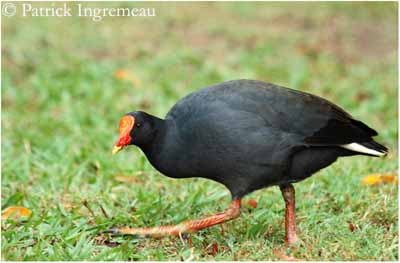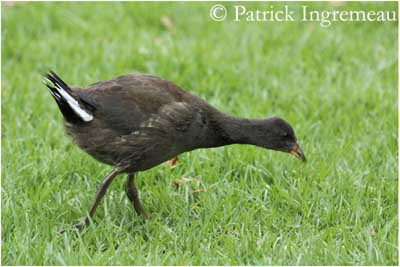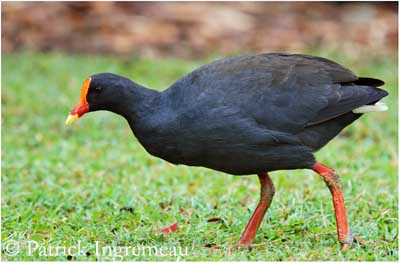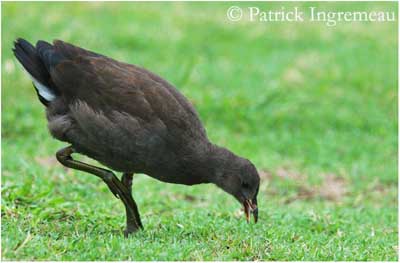
Dusky Moorhen
Gallinula tenebrosa
Gruiforme Order – Rallidae Family
BIOMETRICS:
Length: 34-38 cm
Wingspan: 55-65 cm
DESCRIPTION:
Dusky Moorhen is a medium-sized bird.
Both adults have dark grey-black plumage, and conspicuous white undertail. We can see a brownish tinge on upperparts, rather on wings and rump. Tail is black above, with white outer feathers.
Head is shiny black. Frontal shield and bill are orange-red. Bill has yellow tip. Eyes are brown. Legs and feet are orange-yellow, but they may sometimes have olive-green colour under knees.
Both sexes are similar.
DIET:
Dusky Moorhen feeds mainly on aquatic plants. It feeds by dipping, and also by upending, as numerous ducks.
It also consumes insects, small frogs, fish and worms.
PROTECTION / THREATS / STATUS:
Dusky Moorhen is threatened by habitat loss, mainly by drainage of wetlands which have negative impacts on this species.
However, Dusky Moorhen is common in most parts of its range.
Fr: Gallinule sombre
All : Papuateichhuhn
Esp : Gallineta Enlutada
Ital : Gallinella d'acqua zamperosse
Nd : Zwart Waterhoen
Russe : Тёмная новозеландская камышница
Photographs by Patrick Ingremeau
His website : TAMANDUA
Text by Nicole Bouglouan
Sources:
HANDBOOK OF THE BIRDS OF THE WORLD Volume 3 by Josep del Hoyo-Andrew Elliott-Jordi Sargatal - Lynx Edicions - ISBN : 8487334202
Birds in backyards (Birds Australia and Australian Museum)
Wikipedia (Wikipedia, The Free Encyclopedia)
SORA Searchable Ornithological Research Archive (Blair O. Wolf)

Chicks have black down, bare red forehead, and bill with yellow tip. Legs and feet are black.
Immature is paler and much duller and browner than adults. Bill and frontal shield are black, and bill has yellow-green tip. Legs are olive-green.

VOICE: SOUNDS BY XENO-CANTO
Dusky Moorhen utters harsh shrieks, also sharp, guttural crowing, and loud “kruk” call. It is a noisy species.
HABITAT:
Dusky Moorhen lives in wetlands, freshwater marshes, swamps and rivers. It is often seen in open water with reed bed and other vegetation. It also may be found in parks, pastures and grassy areas close to water.
RANGE:
Dusky Moorhen is found from Indonesia, through New Guinea to Australia.
These three birds have different sizes. New Guinea bird is smaller than Australian. Indonesia species is in decline, due to competition with Common Moorhen in the areas where both species occur.
BEHAVIOUR:
Dusky Moorhen feeds on the ground, and flicks its tail vertically, displaying the conspicuous white undertail feathers. It also feeds in the water, but it doesn’t dive. Its tail is always seen above the surface when upended. It swims with jerking head motion.
Dusky Moorhens live in pairs or in small groups, defending permanent territories in wet areas. These groups may be very aggressive and defend strongly their area against other groups. During these interactions, the bright red-orange shield contrasts with black head, and it is displayed conspicuously, as a signal of status.
Dusky Moorhen is shy and wary, but when it lives in urban parks, it may become very tame.

FLIGHT:
Dusky Moorhen flies with laboured wing beats. Flight is weak and direct, with trailing legs.
REPRODUCTION:
Dusky Moorhen breeds from January to May in the north, and from September to December in the south.
Bulky nest is situated near water, or over water. It is a shallow platform made with reeds and aquatic vegetation, over water or among reeds. Nest may also be floating platform in open water. We can often see an entrance ramp made with trampled reeds.
Several females, two or more, lay their eggs in the same nest. One nest can contain 5 to 18 creamy-white eggs, blotched with reddish-brown.
Incubation lasts about 24 days, shared by all members of the group which also feed the young.
Young fledge at about 28 days of age.
This species may produce two broods in succession per season.
